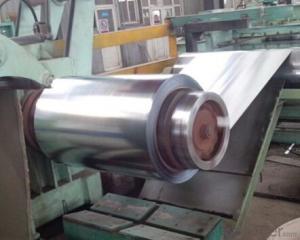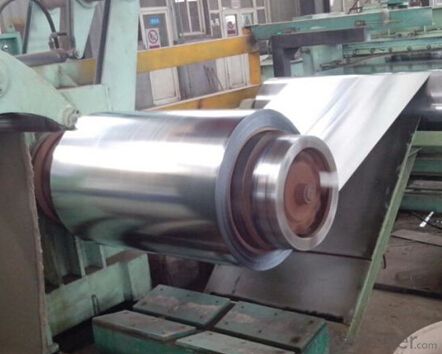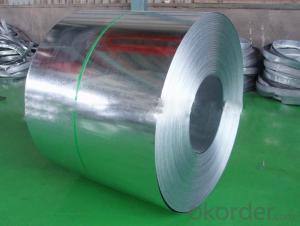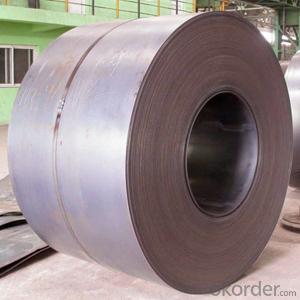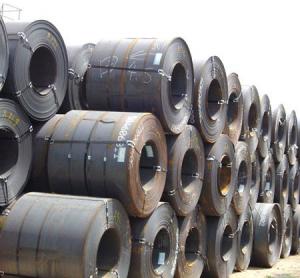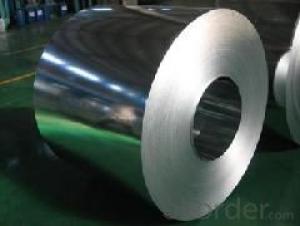Galvanized Hot DIP Galvanized Steel Rolled Coil
- Loading Port:
- Shanghai
- Payment Terms:
- TT OR LC
- Min Order Qty:
- 25 m.t.
- Supply Capability:
- 10000 m.t./month
OKorder Service Pledge
OKorder Financial Service
You Might Also Like
Basic Info.
Model NO.:wit-gic01
Surface Treatment:Galvanized
Certification:ISO, SGS, BV, RoHS, IBR
Technique:Cold Rolled
Standard:ASTM, JIS, GB, AISI, DIN, BS
Steel Grade:SGCC
Zinc Coating:60-120g
Spangle:Minimum Spangle,Regular Spangle
Size:Customized Thickness Width Length
Export Markets:Global
Galvanized steel coil
Size:0.133x1000mm and others .Please check the following form.
Steel grade:SGCC,DX51D+Z and so on.
Certificate:ISO 9001
| COMMODITY | Galvanized steel plate/coil |
| STEEL GRADE | SGCC,SGCD,ASTM A 653 etc. |
| Standard | GB,JIS,DIN,AISI,ASTM |
| Thickness | 0.13mm ~ 3.0mm |
| Width | 700mm 1000mm 1219mm 1250mm |
| length | below 12000mm or coil |
| Coil ID | 508/610mm |
| Coil Weight | 3-12tons |
| Surface | Zinc coating 60-250g/sqm |
FAQ:
Acceptable payment term and way?
T/T,L/C, T/T + L/C, D/P
Acceptable price term
FOB CNF CIF DDU CPT
Do you accept OA payment terms?
Yes, sure, but it normally depending on the order value
Do you have QC team?
Yeah, sure, our QC team is very important, they will keep the qualitycontrol for our products.
What is the validity of your quotation?
Normally 7 days.
What is your advantage?
24 hour quick response /Customer oriented/ Credit foremost/ Top quality Excellent
What is your acceptable payment term?
TT,LC,OA etc
- Q: Help me compare the speed of sound in air, water, and steel please?Thanks.
- Sound travels fastest in steel and slowest in air. Water is in between. This is because the particles in solids are closer together than the particles in liquids or gases, and the particles in liquids are closer together than the particles in gases. The tighter particles are packed in a space, they collide more frequently. This allows sound, which is simply the combined collisions of particles, to travel fastest in solids. So, to reiterate, sound travels fastest in steel, then water, and slowest in air.
- Q: How are steel coils processed and shaped into specific products?
- The production of specific steel products involves a series of steps and techniques using different machinery. Initially, steel coils are unwound and flattened using a decoiler and a leveller. This prepares the coils for further processing. Next, the flattened coils are fed into a rolling mill where they undergo cold rolling. This process involves passing the coils through rollers to reduce thickness, improve surface finish, and enhance strength and hardness. After cold rolling, additional processes like annealing or galvanizing may be applied depending on the desired properties of the final product. Annealing involves heating the coils to a specific temperature and slowly cooling them to relieve internal stresses and improve ductility. Galvanizing, on the other hand, involves coating the coils with a layer of zinc to protect against corrosion. Once these treatments are completed, the steel coils are ready to be shaped into specific products. This can be achieved through cutting, stamping, or forming. Cutting involves trimming the coils into desired sizes or lengths using shears or lasers. Stamping involves using a die and press to shape the coils into intricate designs or patterns. Forming, on the other hand, involves bending or shaping the coils with specialized machinery to create curved or contoured products. Finally, the shaped steel products are inspected for quality and undergo any necessary finishing processes like painting or coating. This ensures that the products meet required specifications and are ready for distribution or further assembly. In conclusion, the transformation of steel coils into specific products involves a combination of steps including unwinding, flattening, cold rolling, annealing or galvanizing, cutting, stamping, forming, inspection, and finishing. Each step is essential in producing high-quality steel products used across various industries.
- Q: What are the different types of steel coil cutting methods?
- There are several different types of steel coil cutting methods, including slitting, shearing, and laser cutting. Slitting involves cutting the coil into narrower strips using rotating circular knives. Shearing is the process of cutting the coil using straight blades to create straight edges. Laser cutting uses a focused laser beam to melt and vaporize the steel, resulting in a precise and clean cut.
- Q: Im going to buy T-304 Stainless Steel exhaust tips for my truck. Is T-304 Stainless Steel good metal?
- Surprisingly any stainless steel is considered soft or tough metal. A hardness tester will bare this out. It resists work hardening which means you can bend it many more times than cold rolled or hot rolled steel before it will break. Your choice is a good one for your intended purpose.
- Q: How are steel coils used in the production of industrial equipment?
- Steel coils are a vital component in the production of industrial equipment. These coils are large, flat rolled sheets of steel that are typically used as raw material in various manufacturing processes. Firstly, steel coils are used for fabrication purposes, where they are cut, shaped, and welded together to create the framework or structure of industrial equipment. This includes machinery, heavy-duty vehicles, storage tanks, and other industrial components. The coils provide the necessary strength and durability to withstand the demanding conditions faced by industrial equipment. Additionally, steel coils are often formed into specific shapes to produce parts and components for industrial machinery. These parts can include gears, shafts, bearings, brackets, and many others. The versatility of steel allows it to be easily manipulated and fabricated into different shapes and sizes, making it an ideal material for such applications. Moreover, steel coils are also used in the construction of industrial equipment, particularly in the manufacturing of boilers, heat exchangers, and pressure vessels. These coils are typically formed into tubes or pipes, which are then welded or brazed together to create the necessary structure for these equipment. The high strength and heat resistance properties of steel make it the preferred material for such applications, ensuring the safe and efficient operation of industrial processes. In summary, steel coils play a crucial role in the production of industrial equipment. They are used as raw material for fabrication, forming parts and components, and constructing crucial equipment such as boilers and pressure vessels. The durability, strength, and versatility of steel make it an indispensable material in the manufacturing industry.
- Q: Can steel coils be used in architectural applications?
- Yes, steel coils can be used in architectural applications. Steel coils are versatile and can be processed into various shapes and forms to meet the unique design requirements of architectural projects. They can be used in the construction of buildings, bridges, and other structures, as well as in the fabrication of architectural elements such as roofing, cladding, and facades. Steel coils offer several advantages in architectural applications. They are highly durable, strong, and resistant to corrosion, making them suitable for long-lasting and low-maintenance structures. Steel coils can also be customized in terms of thickness, width, and surface finish, allowing architects to achieve their desired aesthetic and functional goals. In addition, steel coils are known for their structural stability and load-bearing capacity, which are crucial factors in architectural designs. Their high strength-to-weight ratio makes them an ideal choice for creating large and open interior spaces, as well as for supporting heavy loads in multi-story buildings. Furthermore, steel coils can be easily fabricated and installed, saving time and labor costs during construction. They can be efficiently formed, cut, and welded to create complex shapes or architectural details. Moreover, steel coils can be pre-fabricated off-site, ensuring precision and quality control, and then assembled on-site, reducing construction time and minimizing disruptions to the surrounding environment. Overall, steel coils offer architects and designers a wide range of possibilities in architectural applications. Whether it is for structural support, aesthetic appeal, or functional requirements, steel coils provide a reliable and versatile material option that can meet the demands of modern architectural projects.
- Q: Two different shaving razors I'm looking to buy have different specs. in terms of the metals used for the blade; one being 1045 surgical stainless steel, the other 440 stainless (not sure if its A B or C, but probably 440A or 440B because it's not specified). So which one is better for the intended use as a shaving razor?
- yes a stainless steel 440 knife is really good my uncle bought one back in 1979 and has been having it without any problems the blade is still razor sharp even at 35 years old
- Q: I'm in the process of buying a new car, and wondering if there are more benefits from Aluminum tire rims over Steel. Aluminum wheels cost more, but you'd think that steel would last longer. Are Aluminum wheels just for looks?
- If you got money to waste get the aluminum. Practicality is the steel wheels.
- Q: What are the benefits of using steel coils in the manufacturing of pipes?
- There are several benefits of using steel coils in the manufacturing of pipes. Firstly, steel coils offer high strength and durability, making them capable of withstanding extreme pressure and temperature conditions. This ensures the longevity and reliability of the pipes. Secondly, steel coils provide excellent corrosion resistance, which is crucial for pipes that come into contact with different substances or are used in corrosive environments. Additionally, steel coils allow for seamless production and fabrication of pipes, resulting in a smooth surface finish and uniform dimensions. Lastly, steel coils are readily available and cost-effective, making them a preferred choice for pipe manufacturing.
- Q: density of mild steel (MS) is 7850 KG per metre cube , but i want to know the density of stainless steel
- This Site Might Help You. RE: what is the density of stainless steel? density of mild steel (MS) is 7850 KG per metre cube , but i want to know the density of stainless steel
Send your message to us
Galvanized Hot DIP Galvanized Steel Rolled Coil
- Loading Port:
- Shanghai
- Payment Terms:
- TT OR LC
- Min Order Qty:
- 25 m.t.
- Supply Capability:
- 10000 m.t./month
OKorder Service Pledge
OKorder Financial Service
Similar products
Hot products
Hot Searches
Related keywords
